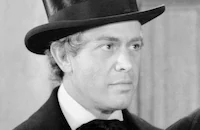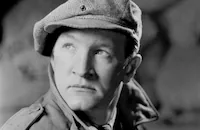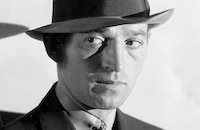You Can't Get Away with Murder

Brief Synopsis
Cast & Crew
Lewis Seiler
Humphrey Bogart
Gale Page
Billy Halop
John Litel
Henry Travers
Film Details
Technical Specs

Synopsis
Madge Stone worries about the influence that Frank Wilson, a cheap gangster, has on her younger brother Johnnie. Johnnie, who has been hardened by the streets of New York's Hell's Kitchen, is impressed by Wilson's seemingly glamorous life of crime, and accompanies the gangster on a gas station robbery. Madge's worries seem to be at an end when her fiancé, night watchman Fred Burke, announces that he is moving the family to Boston where he has found Johnnie a job. That night, however, Johnnie joins Wilson on a pawn shop robbery, and when the owner of the pawn shop tries to stop him, Wilson kills him with Burke's gun, which Johnnie had stolen. Terrified by Wilson's threats about what will happen if he talks, Johnnie returns home. There Madge is about to tell him about their plans for a new life when the police burst in to arrest Johnnie for the gas station robbery. Wilson and Johnnie are sentenced to Sing Sing, where they learn that Burke has been condemned to the death house for the murder of the pawnbroker. As Johnnie wrestles with his conscience about whether he should exonerate Burke of the murder, Wilson intensifies his threats about what will happen to the boy if he talks. While he awaits the results of Burke's appeal, Johnnie is assigned to work in the library, where he flourishes under the care of Pops, a wise old inmate. Upon learning that Burke's appeal has been denied, Johnnie is on the verge of telling the truth when Burke's lawyer terrifies the boy by accusing him of murder. As Madge wages a battle to save Burke, Wilson, worried that Johnnie will confess, decides to kill him during an attempted jail break. Hours before Burke's execution, Wilson and Johnnie stage an aborted jailbreak and Wilson shoots the boy in cold blood. With his dying breath, Johnnie gives a confession which removes Burke from the shadow of the electric chair and replaces him with Wilson.

Director
Lewis Seiler
Cast

Humphrey Bogart

Gale Page

Billy Halop

John Litel

Henry Travers

Harvey Stephens

Harold Huber

Joe Sawyer
Joe Downing

George E. Stone
Joseph King

Joseph Crehan

John Ridgely
Herbert Rawlinson
Gertrude Short
Hal Craig
George Offerman
Ed Brian
Frankie Burke
Robert Strange
Robert E. O'connor
Emory Parnell
Frank Faylen
Cliff Saum
Jack Goodrich
Robert Homans
Nat Carr
John Harron
Joe Devlin
Sidney Bracy
George Taylor
Frank Mayo
Eddy Chandler

Jack Mower
Lane Chandler
Crew
Milo Anderson
Louis Baum
Sam Bischoff
Robert Buckner
Leo F. Forbstein
Kenneth Gamet
James Gibbon
Jo Graham
William Kissell
Sol Polito
Hugh Reticker
Don Ryan
Francis J. Scheid
Jack L. Warner

Film Details
Technical Specs

Articles
You Can't Get Away with Murder (1939)
Synopsis: In a small apartment in New York's Hell's Kitchen, Madge Stone (Page) lives with her younger brother Johnny (Halop). Madge is worried about Johnny and the low-life sorts that he associates with at the local pool hall. She has reason to worry, because low-level hood Frank Wilson (Bogart) has taken Johnny under his wing and into a life of crime; one night Johnny accompanies Frank on a gas station hold-up. Madge's fiancé Fred Burke (Harvey Stephens) announces that he will be moving the Stones to Boston, where he has a job lined up for Johnny. Johnny wants to go out on another outing with Frank, though, and steals a gun from Burke to take along. The job is a pawn shop robbery the shop owner scuffles with Frank, who shoots the old man with Burke's gun. Later, Frank and Johnny are picked up for the gas station job and sent to Sing Sing, while Burke is sent to death row for the pawn shop murder. In prison, Johnny continues to be silent under threats from Wilson, as he works in the library with older inmate Pop (Henry Travers). Burke's lawyer (John Litel) pressures Johnny as his client's appeal is heard.
Billy Halop was a natural choice for the co-starring role of Johnny, the kid corrupted by slick-talking would-be gangster Frank Wilson. Halop had already been a well-paid child actor in radio before beginning his film career; he starred in the title roles of such popular shows as Skippy and Bobby Benson's Adventures, and was earning a cool $750 a week at his peak. In 1936 he was the first actor signed to the Broadway show Dead End, and was paid more than his fellow Dead End Kids (Bobby Jordan, Huntz Hall, Leo Gorcey, Bernard Punsly, and Gabriel Dell) when he was brought to Hollywood by Sam Goldwyn for the film adaptation in 1937. In Dead End Bogart played the gangster Baby Face Martin, who was idolized by the Kids, another reason that the plot of You Can't Get Away with Murder must have had a ring of familiarity with moviegoers.
In his review of You Can't Get Away with Murder for The New York Times, Frank Nugent has some fun with the fact that Warner Bros. had, by 1939, turned out such a long string of prison pictures. He wrote "it is said that there are old extras on the Warner lot who scarcely breathe the air of freedom from one prison picture to another. And Warners' most valuable stock players like Humphrey Bogart, Billy Halop and John Litel are held, not so much by five-year contracts, as by five-year sentences. Or at least so it must seem to them at times." Nugent goes on to single out Halop's role: "It is certainly no use pretending that You Can't Get Away with Murder isn't one of those death-house melodramas where the big punch line in the final sequence is when the warden says: 'Get the Governor on the wire.' Billy Halop, prospective Public Enemy No. 1 of the 'Dead End' boys, is still having interesting trouble with his diphthongs, but we have seen Billy reclaimed so often for society that we are beginning to think he is a sociological pushover. One thing, though, in You Can't Get Away with Murder Billy has finally reached man's estate: he is now being sent to penitentiaries instead of reform schools."
Bogart was only treading water in his movie career in 1939; his best break from gangster roles would come with John Huston's The Maltese Falcon in 1941. Billy Halop should have benefited from the juicy part in You Can't Get Away with Murder, but not many other good roles came his way, and certainly no variety in the characters he played. Halop was the leader of yet another group of bullies in RKO's Tom Brown's School Days (1940), although he co-starred with such players as Cedric Hardwicke, Freddie Bartholomew, and Josephine Hutchinson, a more prestigious group than the Warner Bros. stock company. Halop landed at Universal Pictures, playing group leader of the "Little Tough Guys" (the Dead End Kids minus Gorcey and Jordan), in films like Mob Town (1941), Tough As They Come (1942) and Mug Town (1943), and even a pair of serials, Junior G-Men (1940 12 chapters) and Junior G-Men of the Air (1942 12 chapters).
Following service in WWII, Halop found himself heading up the Gas House Kids (1946) at the low-rent studio PRC. Starring alongside the nearly-forgotten child star, Carl 'Alfalfa' Switzer, this was perhaps the most impoverished variation of the Dead End Kids/Bowery Boys ever to hit the screen. Halop had a more promising role, and top billing, in Dangerous Years (1947), but once again he was playing a young hoodlum in need of reform, and subsequently the acting jobs dried up. According to a profile by David Hayes and Brent Walker in The Films of the Bowery Boys, at this point "...the anguish [Halop] suffered from lack of work led to a drinking problem, a nervous breakdown and a suicide attempt." In the 1950s Halop worked sporadically in television, but he took on other jobs, including electric dryer salesman, restaurant chef, and registered male nurse (he learned nursing skills while taking care of his third wife, who suffered from multiple sclerosis). Through the 1960s, Halop could often be glimpsed on episodic television, usually playing bartenders, garage attendants, elevator operators and the like. His final role of note was a recurring part as Archie Bunker's cab-driving buddy Bert Munson on the long-running TV series All in the Family. Halop died of a heart attack in 1976, at the age of 56.
Producer: Hal B. Wallis
Associate Producer: Samuel Bischoff
Director: Lewis Seiler
Screenplay: Robert Buckner, Kenneth Gamet, Don Ryan, from the play Chalked Out by Jonathan Finn and Lewis E. Lawes
Music: Heinz Roemheld
Cinematography: Sol Polito
Film Editing: James Gibbon
Art Direction: Hugh Reticker
Cast: Humphrey Bogart (Frank Wilson), Gale Page (Madge Stone), Billy Halop (Johnny Stone), John Litel (Attorney Carey), Henry Travers (Pop), Harvey Stephens (Fred Burke), Harold Huber (Tom Scappa), Joe Sawyer (Red), Joe Downing (Smitty), George E. Stone (Toad).
BW-79m.
by John M. Miller

You Can't Get Away with Murder (1939)
Quotes
Trivia
The original play opened in New York on 26 March 1937.
Notes
Working titles of this picture were Crime Is A Racket and Chalked Out. Lewis E. Lawes, the author of the play on which the picture was based, was warden of Sing Sing penitentiary.

Miscellaneous Notes
Released in United States 1939
Released in United States 1939














